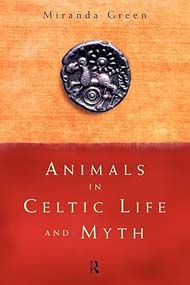Animals in Celtic Life and Myth
Miranda Green
Published by Routledge 1992, 2010
'Profusely illustrated, and making full use of freshly excavated evidence...
her book forms both an excellent introduction to, and a timely round-up of,
a complicated and fascinating subject.'
- The Times Literary Supplement
For the Celts, a rural people whose survival depended greatly upon
their environment, the sanctity of natural phenomena and of the
elements led to extreme respect and veneration of animals. Both wild
and domesticated species became the subject of elaborate rituals and
formed the basis of profound religious beliefs. Animals in Celtic Life and
Myth examines the intimate relationship which developed between
humans and animals, in a society in which animals were central to all
aspects of life.
Miranda Green draws on evidence from a variety of early Celtic
documents, as well as archaeology and iconography, to reveal that the
Celts believed many animals to be sacred, either possessing divine
status in their own right or acting as mediators between gods and
humans. She examines the crucial role of animals in the Celtic
economy, in hunting and warfare, in Celtic art and literature, and in
religion and ritual. This study covers the important period between
800 BC and AD 400, during which much of Europe was turning to
Christianity, with examples ranging from Iceland to Slovakia.
Animals in Celtic Life and Myth will be invaluable to students of
archaeology, anthropology and history, and to all those fascinated by
the Celts.
Miranda Green is Reader in Archaeology and Head Research in
Humanities at the University of Wales College, Newport. She is the
author of The Gods of the Celts, Symbol and Image in Celtic Religions Art,
The Sun-Gods of Ancient Europe and the editor of The Celtic World.
(The text above comes from the back of the book)


